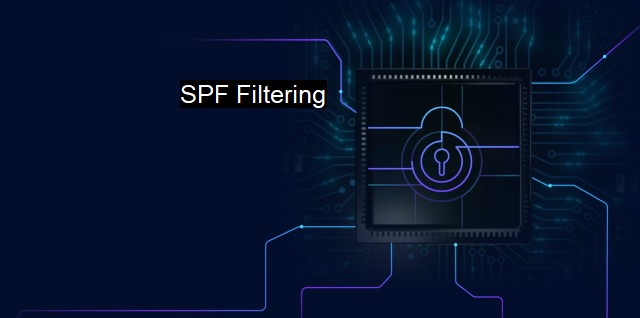What is SPF Filtering?
SPF Filtering: The Solution to Email Security and Privacy in a Hack-Targeted World
In the arena of cybersecurity and antivirus technology, SPF filtering is a method that has gained recognition and usage over the years. Standing for ‘Sender Policy Framework’, SPF is an email-validation technology designed to prevent email spam by detecting email spoofing, a common tactic utilized to create phishing attacks. SPF filtering helps to verify if an email was sent by an authorized sender of the domain mentioned in the email header.Email spoofing is a concept where attackers alter source addresses to appear as if the email is coming from a different domain. Cybercriminals use this deceptive practice to trick individuals into sharing sensitive information under the guise of communication from a trusted sender. Cybersecurity efforts necessary to combat these malicious activities led to the development of mechanism such as SPF.
When an email travels through the internet, it passes through multiple computer systems before landing in the recipient's mailbox. Each system involved plays an integral role in the delivery process. SPF activates during the verification or authentication portion of this pathway, providing layers of protection for the most vulnerable targets. Vetting inbound emails for their authenticity is a key aspect.
SPF filtering leverages DNS (Domain Name System) records to achieve its objectives. Each domain publishes a list of servers authorized to send mails on its behalf as part of its DNS records. As email arrives at a mail server, the SPF filtering system checks with the DNS records of the sender's domain to confirm that the email has originated from a listed, authorized server. If the email fails the SPF check, the email server could implement certain actions like flag the email as spam, quarantine it, or reject it outright.
Understanding that SPF filtering is not a one-size-fits-all solution to email spam or spoofing is vital. Some genuine emails may fail SPF checks due to misconfigurations, outdated DNS or server records, or because they've been forwarded. The more sophisticated cybercriminals may also attempt to bypass SPF protection measures, calling for other security measures to be in place in addition to SPF filtering.
Parallel to SPF, other enhanced email security technologies have been developed, such as DKIM (Domain Keys Identified Mail) and DMARC (Domain-based Message Authentication Reporting & Conformance). These three key pillars of email authentication can work together to provide a more robust level of defense against email spoofing and phishing activities.
DKIM involves encrypting emails with a private cryptographic key, which is then decrypted by the receiver using a public key published in the DNS. An email properly decrypted verifies the email's integrity and the identity of the sender. DMARC, meanwhile, combines the strengths of SPF and DKIM, with an added feature: it allows domain owners to specify actions that recipient domains should take if an email fails SPF or DKIM checks.
Fundamentally, SPF Filtering maps out a pathway to accepting or rejecting an email worthiness of being added to the recipient's inbox. It aims to shield individuals and business alike from cyber threats by lethargically screening incoming emails for any red flags based on preemptive cyber protocols. Equating to a digital bouncer at the door of your inbox, it ensures that only emails from sender's whose identities could be verified via records enter the domain.
While SPF filtering contributes significantly towards secure email communications, it must be employed as part of a broader cybersecurity strategy that includes employee awareness & training, appropriate software solutions, and effective security policies & procedures, among others. it’s important that these strategies evolve with the ever-changing digital threat landscape to provide consistent protection from cyber threats. Cybersecurity is a continuous warfare, and institutions must maintain vigilance to protect their digital assets and reputation from increasingly sophisticated attackers. Needless to say, SPF filtering is a firm footing in this war. It is, undoubtedly, an essential part of today's email security architecture.

SPF Filtering FAQs
What is SPF filtering?
SPF filtering is a cybersecurity technique used to authenticate email messages by verifying if the sender's IP address is authorized to send emails on behalf of a particular domain. This process helps to prevent email spoofing, phishing, and other email-based attacks.How does SPF filtering work?
SPF filtering works by checking the DNS record of the sender's domain to verify if the IP address sending the email is authorized to do so. If the sender's IP address is not authorized, the email will be rejected or marked as spam.What are the benefits of using SPF filtering?
SPF filtering helps to prevent email-based attacks, such as phishing, spoofing, and spam. It also helps to ensure the authenticity of the sender's identity, which is essential for businesses and organizations that rely on email communication.What are the limitations of SPF filtering?
SPF filtering is not foolproof and can be bypassed by attackers using techniques like domain spoofing or email forwarding. SPF also only verifies the domain in the "from" address, and not the actual sender of the email. As such, businesses and organizations should consider implementing additional security measures like DKIM and DMARC to strengthen their email security.| | A | | | B | | | C | | | D | | | E | | | F | | | G | | | H | | | I | | | J | | | K | | | L | | | M | |
| | N | | | O | | | P | | | Q | | | R | | | S | | | T | | | U | | | V | | | W | | | X | | | Y | | | Z | |
| | 1 | | | 2 | | | 3 | | | 4 | | | 7 | | | 8 | | |||||||